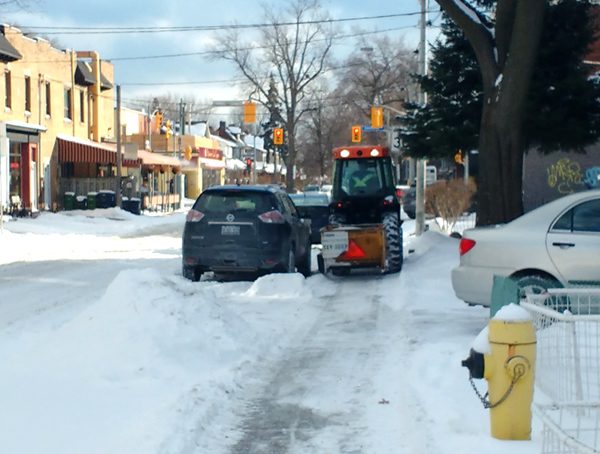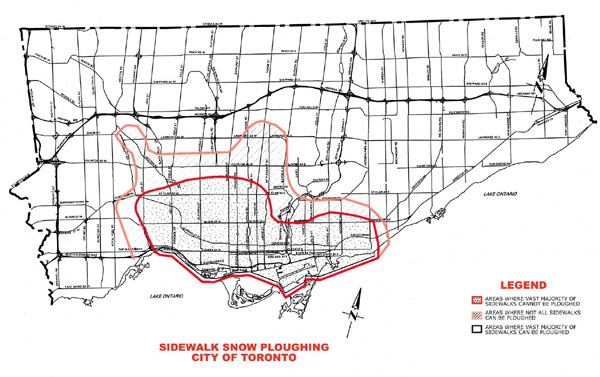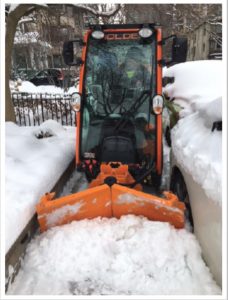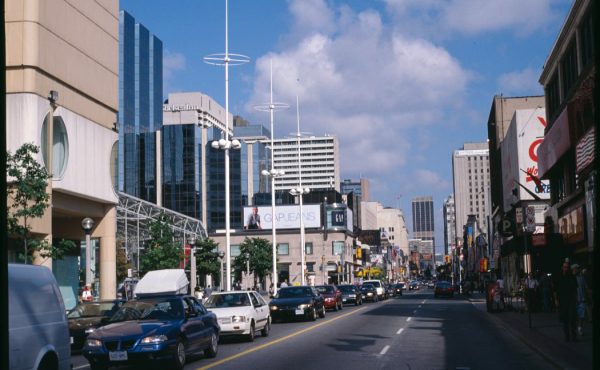I have been writing and advocating about the need to expand sidewalk snow clearing to every sidewalk in the city for what seems like forever. Usually I wrote about it when there was actually snow on the ground — but I’m happy to write about snow when the sidewalks are hot rather than icy if it means I will never have to write about it again.
For a long time, it felt like a hopeless cause, like banging one’s head against a brick wall — or perhaps, an ice wall. We were told over and over again it would be impossible. The sidewalks in the old city were too narrow, and had too many obstacles. The plows couldn’t operate there, and in any case it would be too expensive.
Last week, suddenly, the ice melted. City Council voted overwhelmingly to expand sidewalk snow clearing to every sidewalk in the city (only councillor Stephen Holyday voted against, seeking to deny to people in the old city a service his own constituents benefit from). New plows will be purchased through the existing capital budget, and the operating budget won’t be all that expensive after all.
What happened to trigger this apparently sudden about-face?
The issue goes back to amalgamation in 1998. At the time, the old City of Toronto did not plow its sidewalks — hence the famous “Be nice, clear your ice” ad campaign featuring the drawing of cartoonist Ben Wicks. The suburban municipalities — built with more consistently clear sidewalks (if they exist at all) and plenty of space to dump snow — did plow their sidewalks.
After amalgamation, the former cities began to harmonize their regulations, by-laws, and services. But the amalgamated city also faced a near-constant fiscal crisis, and the last thing it wanted to do was an extensive and expensive expansion of services. So it instead developed a policy that it could not plow sidewalks that were too narrow or where there was no “boulevard” to dump snow (described by the impressive-sounding term “monolithic” sidewalks), which conveniently happened to largely coincide with the old part of the city where sidewalk plowing was not an existing service. Those who lived in this “no-plow” zone had to shovel the sidewalks in front of their residence or business themselves.
The era after amalgamation also saw the creation of the Toronto Pedestrian Committee, a citizen advisory committee to City Council (of which I was a member 2003-2010), and a growing consciousness of the value of getting people walking and the importance of accessibility, notably for those with visual and mobility challenges and for seniors. The lack of sidewalk snow plowing reduced walkability and accessibility, because although property owners were required to clear the sidewalk in front of their property, inevitably some didn’t, creating dangerous patches on any walking route. Slips and falls, a Toronto Public Health study showed, cause a considerable amount of pain and lost time and income to Torontonians, and are particularly dangerous for seniors.
The Toronto Pedestrian Committee pushed to have sidewalks in the old city cleared of snow, but to no avail, although there were marginal improvements in having some sidewalks on main streets plowed.
After the Committee was abolished in 2010, the subsequent advocacy group Walk Toronto, of which I am a member, took up the challenge. We prepared a report (by my Walk Toronto colleague Michael Black) that showed that other cities, such as Ottawa and Montreal, were able to clear snow from narrow sidewalks, and even that comparable sidewalks in areas such as the former East York were already being plowed by the city. We proposed the idea of doing a pilot project to test the practical issues around mechanical sidewalk snow plowing. We met with Transportation Services staff multiple times to try to get some movement on sidewalk snow clearing.
It was interesting that some members of staff were unhappy that the City offered such a low level of service. They had come from suburban departments that were proud of the excellent services they had offered, and they were disappointed that they no longer offered the same high level of service. On the other hand, some staff were completely unsympathetic and were focused on deflecting our arguments and proposals.
A few incremental improvements were introduced, such as getting main street sidewalks plowed systematically and some expansion around the edges of the zone, such as streets north of the Danforth. But the City also came up with a report claiming that all the downtown residential sidewalks would have to be shovelled manually, at a cost of $10 million a year (PDF), to justify not taking any additional action.
But then things began to shift. There was a change in personnel at Transportation Services. And then came the harsh winter of 2019. With sidewalks perpetually blocked by snow and ice, the Mayor’s office was deluged by calls from residents of the old city complaining about dangerous sidewalks. They were both independent calls, and calls organized by residents’ associations — notably including well-off residential neighbourhoods in mid-town that are bastions of support for Mayor Tory. The Mayor asked for a report.
That report, done by an independent consultancy, eventually recommended trying a pilot project to test the problems and solutions of plowing the narrow and cramped sidewalks of the old city. Council authorized nine pilot projects, one in each of the nine wards that did not have sidewalk plowing.
Transportation Services tells us that the final piece of the puzzle was new technology — new, better-designed and smaller sidewalk plows. I’m a touch skeptical about this — as noted before, other cities have managed to plow narrow sidewalks with older sidewalk plows, and some narrow sidewalks in Toronto were already plowed. However, a good way to an engineer’s heart is a cool new machine, so if that’s what it took to bring Transportation staff around, that’s all to the good. (During the City Council debate, councillor and Infrastructure and Environment Committee chair Jennifer McKelvie referred to the new plows as “cool” more than once.)
There’s also no doubt that these new machines are better. As staff explained in their consultations about the outcome of the pilot program, because the older parts of Toronto have never had sidewalk plowing, the City has not been particularly diligent about removing the kind of sidewalk obstructions homeowners often create, such as hedges growing over the sidewalk or fences and retaining walls built too close to the sidewalk — unlike other cities where those would be noticed and dealt with quickly due to sidewalk snow plowing needs. The City has also, it should be added, created its own obstructions, quite often placing poles for lights, utilities, and signs in ways that severely narrow the sidewalk.
The new machines are built more compactly than old ones, and have plows that can both shift which side they are dumping snow on, and also turn into a V shape to squeeze through narrow spaces. These features also reduce the danger of causing damage to street furniture, parked cars, or property.
In the event, it turned out that, especially with the new machines, obstructions were much less of a problem than had always been feared. It turned out that 90% of the sidewalks in the pilot project could be cleared by the machines. In the summer of 2020, staff also did a manual survey of every inch of sidewalk in the no-plow zone, and determined that 91% could be plowed mechanically — only 111 km of sidewalk was too obstructed. In a heartening twist, the City committed to finding a way to clear those remaining kilometres as well (e.g. snowblowers).
City staff also promised to look at ways to resolve those remaining obstructions, for example, talking to homeowners whose plants overgrow the sidewalk. I’m hoping that this new awareness will also encourage the City to address places where City infrastructure blocks sidewalks excessively, which would be a great benefit for accessibility in general.
The new plows will be run by city staff — possibly seasonal summer staff hired for the winter too, who can take on other work when there’s no snowfall — rather than contractors, which will hopefully result in better training, experience, and accountability in terms of not causing damage to street furniture and property on these sometimes tricky routes. During the council debate, in response to a question by Deputy Mayor Minnan-Wong, staff calculated that the cost per kilometre will actually be less expensive than the cost of the contractors currently used to plow sidewalks in suburban areas. (As well, although this was not discussed, because the old city is denser, each kilometre plowed will serve more residents)
The new machines also appear to have better salt management. Sidewalk plows distribute salt at the rear because plows don’t scrape to the bare surface — there’s always a thin layer of snow or ice left behind. On the roadway that’s quickly dispersed by car tires, but on sidewalks that can stay and create a dangerous layer for slips and falls, so salt is needed in addition to get rid of that thin residual layer. The old sidewalk plows dumped a lot of salt, rather unevenly — there’s hope the new plows will distribute less salt, but more evenly.
It seems like the desire to provide good service to Torontonians has, in the end, got the upper hand in this instance. Combined with a reasonable cost (and savings from the program that manually cleared snow for seniors, and probably savings from the millions of dollars a year the City pays out for liability claims from slips and falls), and a new commitment by politicians to ensure accessibility, what once looked like an impossible task has become reality.
During the City Council debate, several councillors pointed out that sidewalk plows can take a while before they get to all sidewalks, and that many Torontonians will still go out and shovel their sidewalks. Indeed, that will continue to be a useful service to neighbours. The thing is, though, that any property that doesn’t do so — and experience shows that there are many — will now also get their sidewalks cleared, meaning that the sidewalk becomes a consistently clear route usable by far more people. (As well, the City won’t be able to buy all the new plows it needs this year, so the service won’t be fully universal until the winter of 2022-23).
It’s interesting to consider that sidewalk snow plowing is, in some ways, a benefit that the old city is gaining from being merged with the suburbs. It is, effectively, one of the very last harmonizations of services in the long process of amalgamation. But it’s also a result of a greater understanding that walking and accessibility are vital for a city’s health, whether in the older or the newer parts of the city.








3 comments
It might have been the impending lawsuits that were brewing from accessibility advocates.
I have hated the sidewalk plows that have plied our street for as long as I have lived here. We have two windrows to clear rather than one. One year they turned the entire street’s length of sidewalk into an ice rink due to the windrows of slush the plow left behind which did not allow the melt water to escape. Maybe our street is particularly good about shovelling, but we all almost always shovel before the plow comes. When we don’t beat it, we end up shavelling the salt onto our boulevards as we clear driveways, and the sidewalk yet again. There is very little room to put snow. I get it, some can’t shovel the sidewalk, and certainly parks and the like need the city to do that job. But I will warn you that the sidewalk plow may not be what you were hoping for.
We live in Scarborough and currently have sidewalk plowing. We did not have sidewalk plowing prior to amalgamation, it was a North York thing.
I will echo the comments above that it can have troubles. I will also say that the bigger benefit is the windrow clearing at the driveway end.